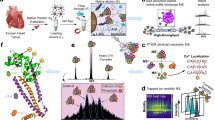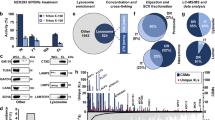Abstract
Because of their sensitivity to solubilizing detergents, membrane protein assemblies are difficult to study. We describe a protocol that covalently conserves protein interactions through time-controlled transcardiac perfusion cross-linking (tcTPC) before disruption of tissue integrity. To validate tcTPC for identifying protein-protein interactions, we established that tcTPC allowed stringent immunoaffinity purification of the γ-secretase complex in high salt concentrations and detergents and was compatible with mass spectrometric identification of cross-linked aph-1, presenilin-1 and nicastrin. We then applied tcTPC to identify more than 20 proteins residing in the vicinity of the cellular prion protein (PrPC), suggesting that PrP is embedded in specialized membrane regions with a subset of molecules that, like PrP, use a glycosylphosphatidylinositol anchor for membrane attachment. Many of these proteins have been implicated in cell adhesion/neuritic outgrowth, and harbor immunoglobulin C2 and fibronectin type III–like motifs.
This is a preview of subscription content, access via your institution
Access options
Subscribe to this journal
Receive 12 print issues and online access
$209.00 per year
only $17.42 per issue
Buy this article
- Purchase on Springer Link
- Instant access to full article PDF
Prices may be subject to local taxes which are calculated during checkout




Similar content being viewed by others
References
Auerbach, D., Thaminy, S., Hottiger, M.O. & Stagljar, I. The post-genomic era of interactive proteomics: facts and perspectives. Proteomics 2, 611–623 (2002).
Reiss, T. Drug discovery of the future: the implications of the human genome project. Trends Biotechnol. 19, 496–499 (2001).
Selkoe, D.J. Alzheimer's disease: genes, proteins, and therapy. Physiol. Rev. 81, 741–766 (2001).
Haass, C. & Steiner, H. Alzheimer disease gamma-secretase: a complex story of GxGD-type presenilin proteases. Trends Cell Biol. 12, 556–562 (2002).
Rogaev, E.I. et al. Familial Alzheimer's disease in kindreds with missense mutations in a gene on chromosome 1 related to the Alzheimer's disease type 3 gene. Nature 376, 775–778 (1995).
Sherrington, R. et al. Cloning of a gene bearing missense mutations in early-onset familial Alzheimer's disease. Nature 375, 754–760 (1995).
Yu, G. et al. Nicastrin modulates presenilin-mediated notch/glp-1 signal transduction and βAPP processing. Nature 407, 48–54 (2000).
Goutte, C., Tsunozaki, M., Hale, V.A. & Priess, J.R. APH-1 is a multipass membrane protein essential for the Notch signaling pathway in Caenorhabditis elegans embryos. Proc. Natl. Acad. Sci. USA 99, 775–779 (2002).
Francis, R. et al. aph-1 and pen-2 are required for Notch pathway signaling, gamma-secretase cleavage of betaAPP, and presenilin protein accumulation. Dev. Cell 3, 85–97 (2002).
Gorodinsky, A. & Harris, D.A. Glycolipid-anchored proteins in neuroblastoma cells form detergent-resistant complexes without caveolin. J. Cell Biol. 129, 619–627 (1995).
Naslavsky, N., Stein, R., Yanai, A., Friedlander, G. & Taraboulos, A. Characterization of detergent-insoluble complexes containing the cellular prion protein and its scrapie isoform. J. Biol. Chem. 272, 6324–6331 (1997).
Taraboulos, A. et al. Cholesterol depletion and modification of COOH-terminal targeting sequence of the prion protein inhibits formation of the scrapie isoform. J. Cell Biol. 129, 121–132 (1995).
Vey, M. et al. Subcellular colocalization of the cellular and scrapie prion proteins in caveolae-like membranous domains. Proc. Natl. Acad. Sci. USA 93, 14945–14949 (1996).
Kaneko, K. et al. COOH-terminal sequence of the cellular prion protein directs subcellular trafficking and controls conversion into the scrapie isoform. Proc. Natl. Acad. Sci. USA 94, 2333–2338 (1997).
Meier, P. et al. Soluble dimeric prion protein binds PrPScin vivo and antagonizes prion disease. Cell 113, 49–60 (2003).
Wells, J. & Farnham, P.J. Characterizing transcription factor binding sites using formaldehyde crosslinking and immunoprecipitation. Methods 26, 48–56 (2002).
Jackson, V. Formaldehyde cross-linking for studying nucleosomal dynamics. Methods 17, 125–139 (1999).
Orlando, V., Strutt, H. & Paro, R. Analysis of chromatin structure by in vivo formaldehyde cross-linking. Methods 11, 205–214 (1997).
Fragoso, G. & Hager, G.L. Analysis of in vivo nucleosome positions by determination of nucleosome-linker boundaries in crosslinked chromatin. Methods 11, 246–252 (1997).
Hannah, M.J., Weiss, U. & Huttner, W.B. Differential extraction of proteins from paraformaldehyde-fixed cells: lessons from Synaptophysin and other membrane proteins. Methods 16, 170–181 (1998).
Schmitt-Ulms, G. et al. Binding of neural cell adhesion molecules (N-CAMs) to the cellular prion protein. J. Mol. Biol. 314, 1209–1225 (2001).
Edbauer, D. et al. Reconstitution of gamma-secretase activity. Nat. Cell Biol. 5, 486–488 (2003).
Büeler, H. et al. Normal development and behaviour of mice lacking the neuronal cell-surface PrP protein. Nature 356, 577–582 (1992).
Holst, B.D. et al. Allosteric modulation of AMPA-type glutamate receptors increases activity of the promoter for the neural cell adhesion molecule, N-CAM. Proc. Natl. Acad. Sci. USA 95, 2597–2602 (1998).
Chen, S., Mange, A., Dong, L., Lehmann, S. & Schachner, M. Prion protein as trans-interacting partner for neurons is involved in neurite outgrowth and neuronal survival. Mol. Cell. Neurosci. 22, 227–233 (2003).
Yu, G. et al. The presenilin 1 protein is a component of a high molecular weight intracellular complex that contains beta-catenin. J. Biol. Chem. 273, 16470–16475 (1998).
Vinson, M. et al. Lipid rafts mediate the interaction between myelin-associated glycoprotein (MAG) on myelin and MAG-receptors on neurons. Mol. Cell. Neurosci. 22, 344–352 (2003).
Ehehalt, R., Keller, P., Haass, C., Thiele, C. & Simons, K. Amyloidogenic processing of the Alzheimer beta-amyloid precursor protein depends on lipid rafts. J. Cell Biol. 160, 113–123 (2003).
Jin, T. et al. The chaperone protein BiP binds to a mutant prion protein and mediates its degradation by the proteasome. J. Biol. Chem. 275, 38699–38704 (2000).
Yehiely, F. et al. Identification of candidate proteins binding to prion protein. Neurobiol. Dis. 3, 339–355 (1997).
Vincent, B. et al. The disintegrins ADAM10 and TACE contribute to the constitutive and phorbol ester-regulated normal cleavage of the cellular prion protein. J. Biol. Chem. 276, 37743–37746 (2001).
Fiore, F. et al. The regions of the Fe65 protein homologous to the phosphotyrosine interaction/phosphotyrosine binding domain of Shc bind the intracellular domain of the Alzheimer's amyloid precursor protein. J. Biol. Chem. 270, 30853–30856 (1995).
Olive, S., Dubois, C., Schachner, M. & Rougon, G. The F3 neuronal glycosylphosphatidylinositol-linked molecule is localized to glycolipid-enriched membrane subdomains and interacts with L1 and fyn kinase in cerebellum. J. Neurochem. 65, 2307–2317 (1995).
Munro, S. Lipid rafts: elusive or illusive? Cell 115, 377–388 (2003).
Brown, D.A. & Rose, J.K. Sorting of GPI-anchored proteins to glycolipid-enriched membrane subdomains during transport to the apical cell surface. Cell 68, 533–544 (1992).
von Haller, P.D., Donohoe, S., Goodlett, D.R., Aebersold, R. & Watts, J.D. Mass spectrometric characterization of proteins extracted from Jurkat T cell detergent-resistant membrane domains. Proteomics 1, 1010–1021 (2001).
Bini, L. et al. Extensive temporally regulated reorganization of the lipid raft proteome following T-cell antigen receptor triggering. Biochem. J. 369, 301–309 (2003).
Foster, L.J., De Hoog, C.L. & Mann, M. Unbiased quantitative proteomics of lipid rafts reveals high specificity for signaling factors. Proc. Natl. Acad. Sci. USA 100, 5813–5818 (2003).
Madore, N. et al. Functionally different GPI proteins are organized in different domains on the neuronal surface. EMBO J. 18, 6917–6926 (1999).
Bouillot, C., Prochiantz, A., Rougon, G. & Allinquant, B. Axonal amyloid precursor protein expressed by neurons in vitro is present in a membrane fraction with caveolae-like properties. J. Biol. Chem. 271, 7640–7644 (1996).
Ikezu, T. et al. Caveolae, plasma membrane microdomains for alpha-secretase-mediated processing of the amyloid precursor protein. J. Biol. Chem. 273, 10485–10495 (1998).
Wong, W. & Schlichter, L.C. Differential recruitment of Kv1.4 and Kv4.2 to lipid rafts by PSD-95. J. Biol. Chem. 279, 444–452 (2004).
Nadal, M.S. et al. The CD26-related dipeptidyl aminopeptidase-like protein DPPX is a critical component of neuronal A-type K+ channels. Neuron 37, 449–461 (2003).
Pelkmans, L., Puntener, D. & Helenius, A. Local actin polymerization and dynamin recruitment in SV40-induced internalization of caveolae. Science 296, 535–539 (2002).
Nabi, I.R. & Le, P.U. Caveolae/raft-dependent endocytosis. J. Cell Biol. 161, 673–677 (2003).
Supattapone, S. et al. Identification of two prion protein regions that modify scrapie incubation time. J. Virol. 75, 1408–1413 (2001).
Williamson, R.A. et al. Mapping the prion protein using recombinant antibodies. J. Virol. 72, 9413–9418 (1998).
Clauser, K.R., Baker, P. & Burlingame, A.L. Role of accurate mass measurement (±10 ppm) in protein identification strategies employing MS or MS/MS and database searching. Anal. Chem. 71, 2871–2882 (1999).
Acknowledgements
We thank Paul Fraser for the generous supply of aph-1–directed antibodies. N-CAM–knockout mice were generously provided by Kathryn Crossin. We also thank the Hunter's Point Animal Facility. This work was supported by grants from the National Institutes of Health (nos. AG02132 and AG010770) and a gift from the G. Harold and Leila Y. Mathers Charitable Foundation. LC/MS/MS was carried out in the UCSF Mass Spectrometry Facility, supported by National Institutes of Health grant no. NCRR RR01614.
Author information
Authors and Affiliations
Corresponding authors
Ethics declarations
Competing interests
S.J.D., S.B.P. and F.E.C. have financial interests in InPro Biotechnology.
Supplementary information
Rights and permissions
About this article
Cite this article
Schmitt-Ulms, G., Hansen, K., Liu, J. et al. Time-controlled transcardiac perfusion cross-linking for the study of protein interactions in complex tissues. Nat Biotechnol 22, 724–731 (2004). https://doi.org/10.1038/nbt969
Received:
Accepted:
Published:
Issue Date:
DOI: https://doi.org/10.1038/nbt969
This article is cited by
-
Genetically engineered cellular models of prion propagation
Cell and Tissue Research (2023)
-
The function of the cellular prion protein in health and disease
Acta Neuropathologica (2018)
-
Membrane-enriched proteome changes and prion protein expression during neural differentiation and in neuroblastoma cells
BMC Genomics (2017)
-
A ZIP6-ZIP10 heteromer controls NCAM1 phosphorylation and integration into focal adhesion complexes during epithelial-to-mesenchymal transition
Scientific Reports (2017)
-
N-ethylmaleimide-sensitive factor interacts with the serotonin transporter and modulates its trafficking: implications for pathophysiology in autism
Molecular Autism (2014)



